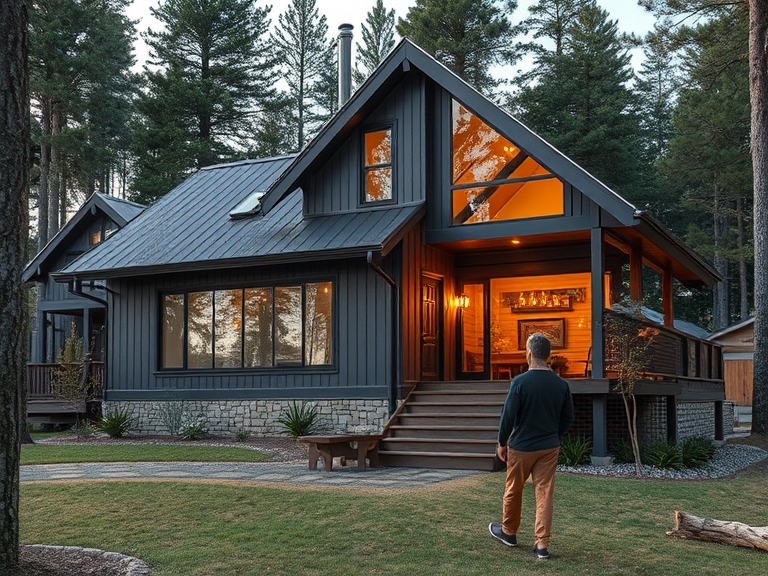Worried about fire safety when building your dream home? Traditional wood-frame homes are highly flammable, putting your safety at risk. That’s where steel homes come in. Built with all-steel construction, these homes offer a higher level of fire resistance. Steel doesn’t ignite or contribute to the spread of fire like wood does, making it a safer option for your home. In this article, we’ll dive into the specific ways that steel homes keep you safe from fire, comparing them to traditional homes and exploring additional fire safety features you can incorporate.
The Science Behind Steel’s Fire Resistance
Steel’s unique properties make it a champion in fire resistance. Unlike wood, steel does not ignite or add fuel to a fire. Wood can catch fire easily and help the fire spread, making it dangerous to use for construction. Steel, on the other hand, remains stable even when exposed to high temperatures.
Steel withstands extreme heat, staying strong and reliable under pressure. This means that in the event of a fire, the steel structure of your home remains intact for a longer time. This gives firefighters more time to respond and allows occupants to evacuate safely. Steel’s non-combustible nature ensures that the fire does not spread quickly, minimizing potential damage.
Steel stays safe under heat without releasing harmful, toxic smoke. In contrast, burning materials like wood and plastic releases harmful gasses that can be deadly. Keeping the air clearer in an emergency can significantly increase survival chances.
Comparing Steel Homes to Traditional Homes in Fire Safety
When it comes to fire safety, steel homes have clear advantages over traditional wood-framed homes. Wood catches fire easily, spreading flames at alarming speeds. This can lead to a complete loss of property and puts lives at greater risk.
In comparison, steel homes do not ignite. Steel’s fire-resistant properties create a barrier that slows down the spread of fire. This can mean the difference between a small, manageable fire and a devastating blaze. Traditional materials like drywall and insulation can also catch fire easily, whereas steel structures provide a much safer alternative.
Additionally, steel homes are less likely to collapse during a fire. Wood can burn through, causing the building to become unstable and collapse. Steel, however, retains its structural integrity for a longer time under extreme heat. This stability ensures safer evacuations and gives firefighters a reliable framework to work within.
Enhancing Fire Safety Features in Steel Homes
While steel homes are naturally more fire-resistant, you can enhance their safety features even further. Smartly placed smoke detectors and alarms provide critical early warnings. This gives you more time to react and evacuate if necessary. Make sure these devices are regularly tested and maintained for optimal functionality.
Fire-resistant insulation materials can add another layer of protection. Unlike traditional insulation, which can catch fire, fire-resistant options help prevent the spread of flames. Using materials such as mineral wool or fiberglass can make a significant difference in overall fire safety.
Additionally, integrating fire doors and fire-rated windows can further secure your home. These specially designed doors and windows withstand high temperatures and prevent the fire from spreading to different areas of your home. Automatic sprinkler systems act swiftly to control and extinguish fires, helping to control and extinguish flames before they grow larger. With these added precautions, you can maximize the safety of your steel home.
Real-Life Benefits of Fire-Resistant Steel Homes
Owning a fire-resistant steel home offers numerous benefits that go beyond just safety. Top of the list? Peace of mind you can count on. Knowing that your home is built from materials that are less likely to catch fire or collapse means you can feel more secure. This is especially crucial in areas prone to wildfires or other fire hazards.
Steel homes often come with the perk of lower insurance premiums. Many insurance companies recognize the fire-resistant qualities of steel homes and may offer lower rates compared to traditional wood-frame homes. This can result in significant savings over time, making steel homes more cost-effective in the long run.
Another practical benefit is the reduced need for repairs and maintenance after a fire. In the unfortunate event of a fire, steel homes are more likely to suffer less damage, both structurally and financially. This means fewer costly repairs and quicker recovery times. In sum, choosing a steel home not only keeps you safer but also provides several added advantages that can improve your quality of life.
Conclusion
Steel homes are your go-to for unmatched fire safety and countless other benefits. The inherent fire-resistant properties of steel make it a superior choice for construction, especially compared to traditional wood-frame homes.
Ready to explore the fire-resistant benefits of steel homes in Texas? Get started on your journey to a safer, smarter home with Wink Panels LLC today!




